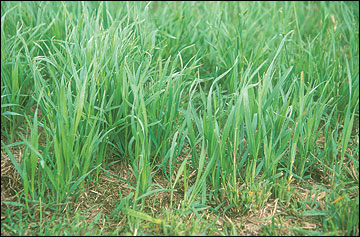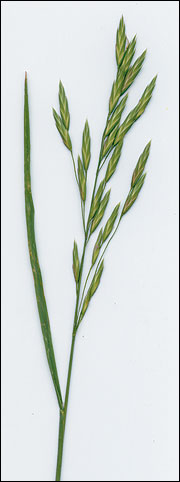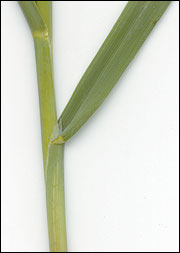Prairiegrass (Bromus wildenowii Kunth)
Cool-season grasses
Prairiegrass, often called Matua grass, is a cool-season perennial bunchgrass. Despite its name, prairiegrass is not native to North America. Prairiegrass is adapted to well-drained and fertile soils where the soil pH is 6.0–7.0. Generally, soils that support good alfalfa production work well for prairiegrass. Prairiegrass produces well in summer as long as soil moisture is adequate, and it overwinters well if a 5-inch stubble is left in autumn. Despite the productivity of prairiegrass under ideal conditions, individual plants do not persist well in the Midwest. Stands are best maintained by allowing for a reseeding period every year. One reason prairiegrass does not persist well is that it is a “jointed grass.” This means that prairiegrass elevates its growing point above ground during tiller development. Grazing or cutting prairiegrass after the growing point has been elevated above grazing or cutting height dramatically reduces subsequent regrowth and may result in plant death. As a result, prairiegrass does not tolerate continuous grazing, so it is best suited for rotational grazing with long rest periods.
 Prairiegrass
Prairiegrass
 Yield distribution of Prairiegrass in Missouri.
Yield distribution of Prairiegrass in Missouri.
- Origin: The Pampas grasslands of South America
- Adaptation to Missouri: Statewide
- Growth habit: Short-lived, perennial bunchgrass.
- Blade: Emerging leaf rolled, but may appear folded. Upper surface pubescent with hairs in distinct rows, bottom half often glabrous, margins rough.
- Sheath: Oval, densely covered with soft hairs, slightly compressed, keeled.
- Ligule: Membranous, white, fringed, split along margin, about 1⁄3 inch long.
- Auricles: Absent.
- Seed head: Open, drooping panicle with flat, compressed and large spikelets.
- Fertilization: Apply 30 to 40 lb N/acre in early spring followed by 30 to 40 lb N/acre after each grazing to maximize regrowth. Phosphorus and potassium to soil test.
- Timing of production: Early spring; late summer and early autumn.
- When to begin grazing: When the grass reaches 8 to 10 inches in height. Allow a regrowth period of 28 to 42 days.
- When to cut for hay: Boot stage
- Lowest cutting or grazing height: 3 inches
- Fall management: Light grazing possible in fall if a 5-inch stubble is left for winter.

